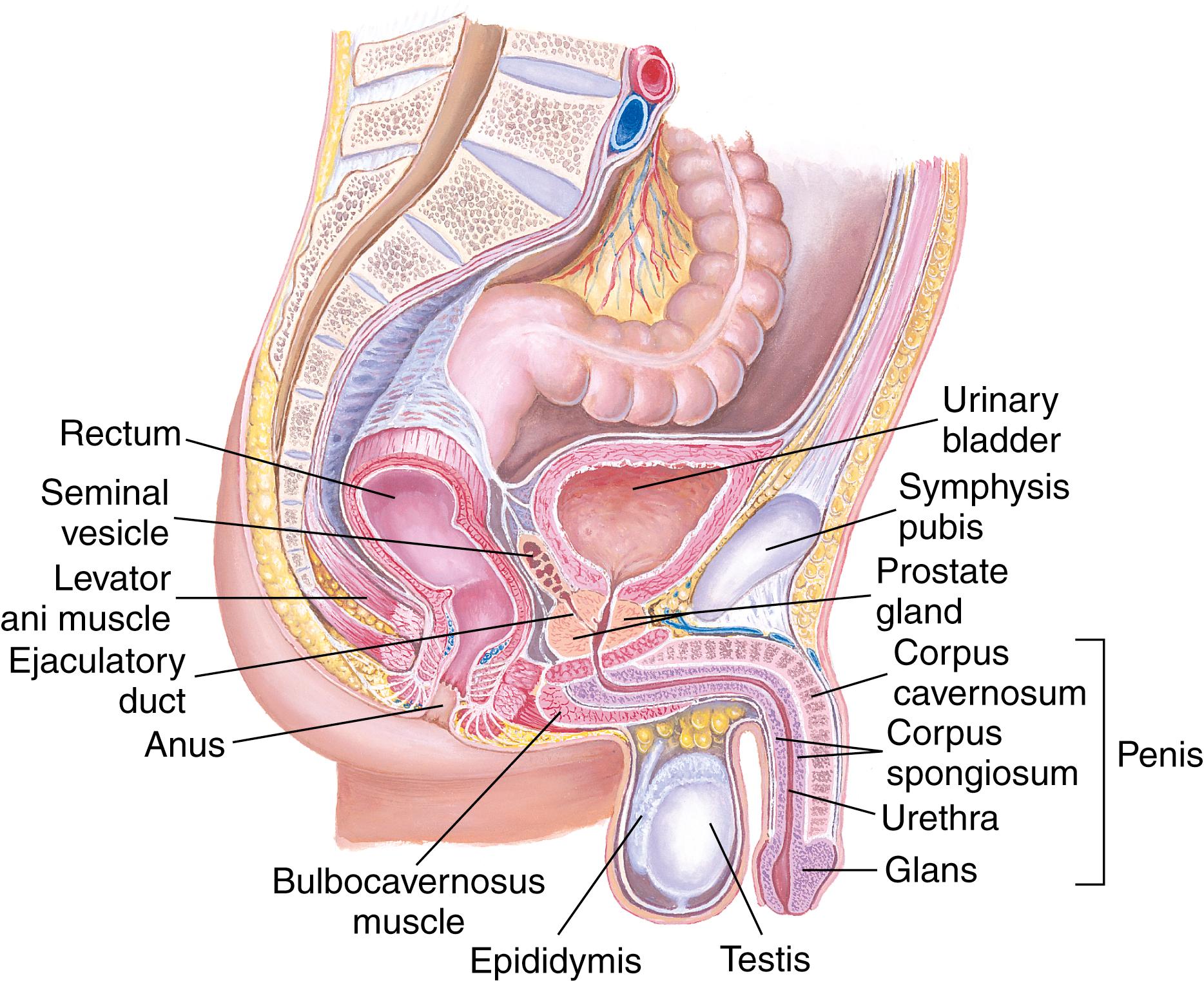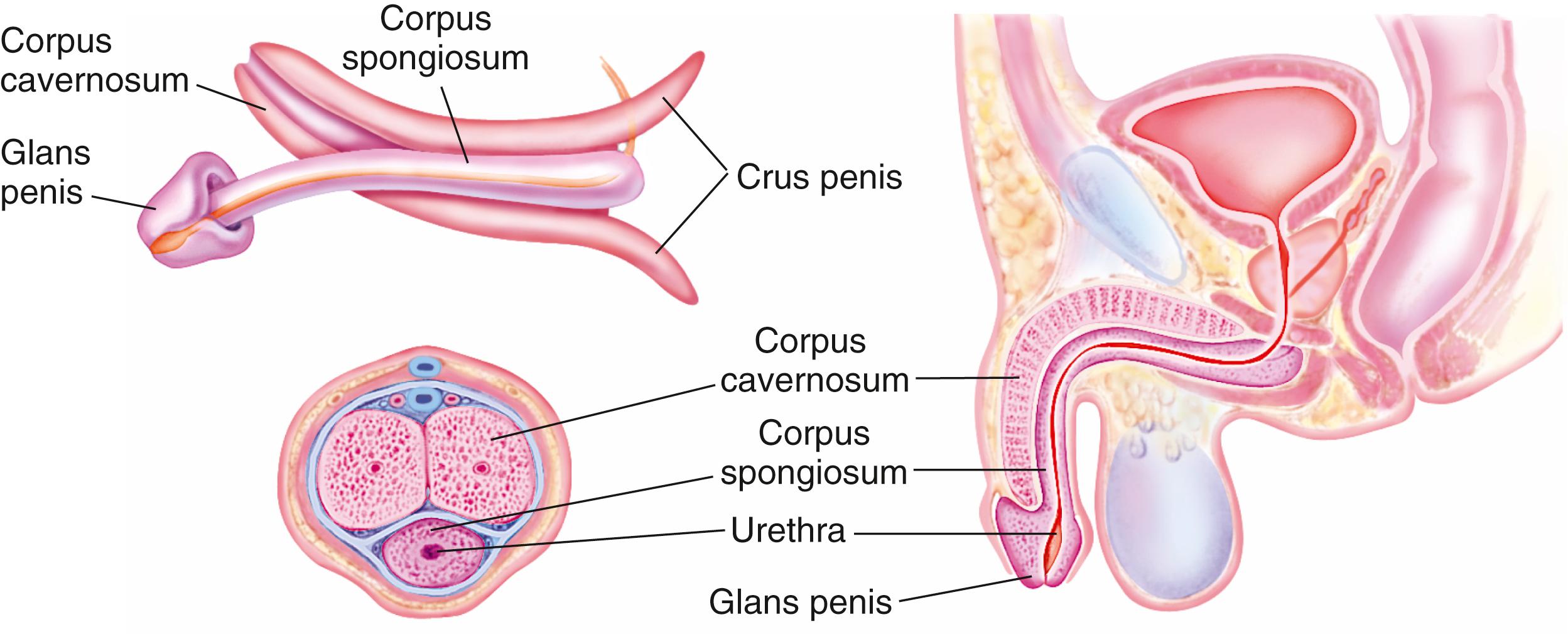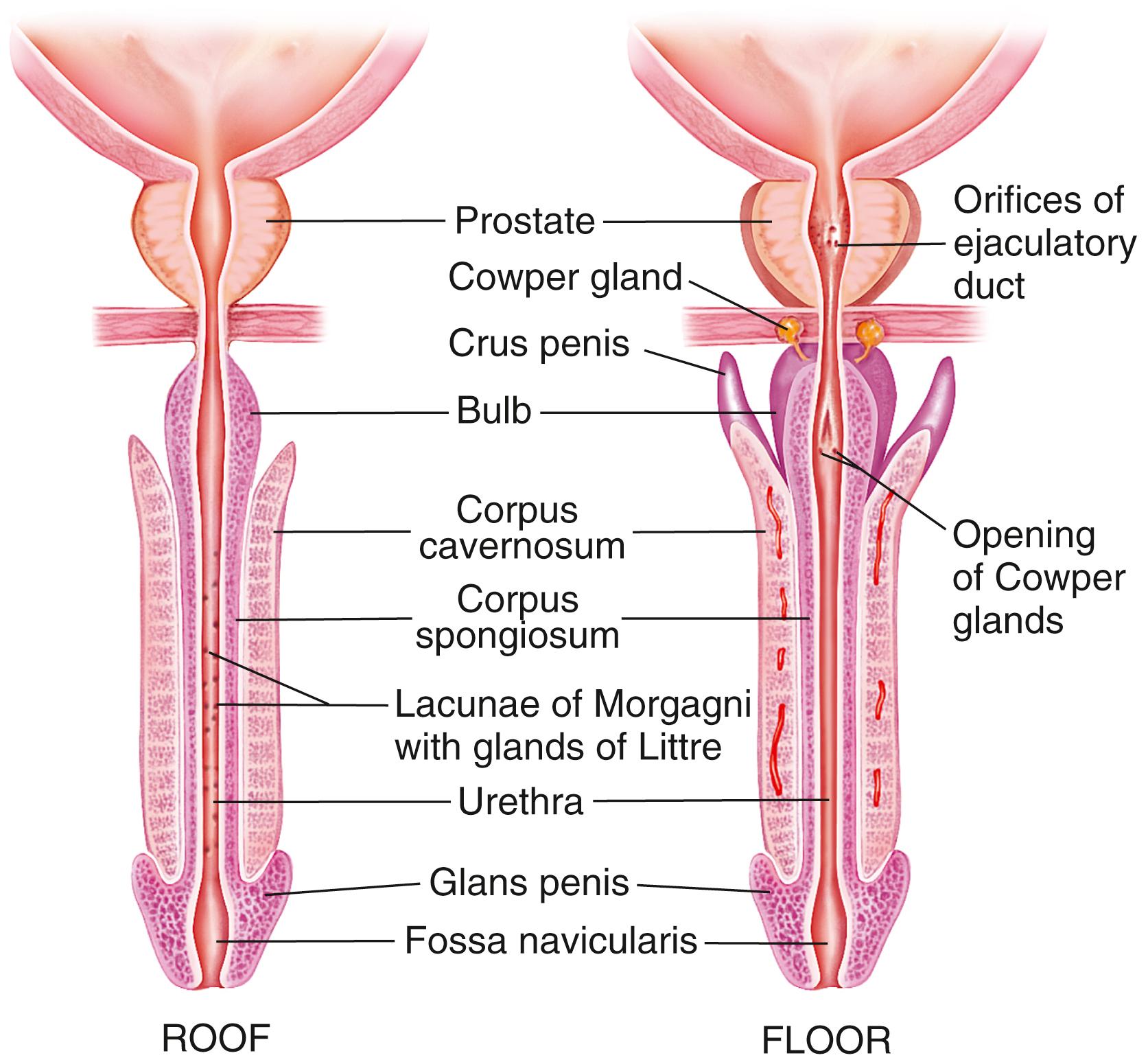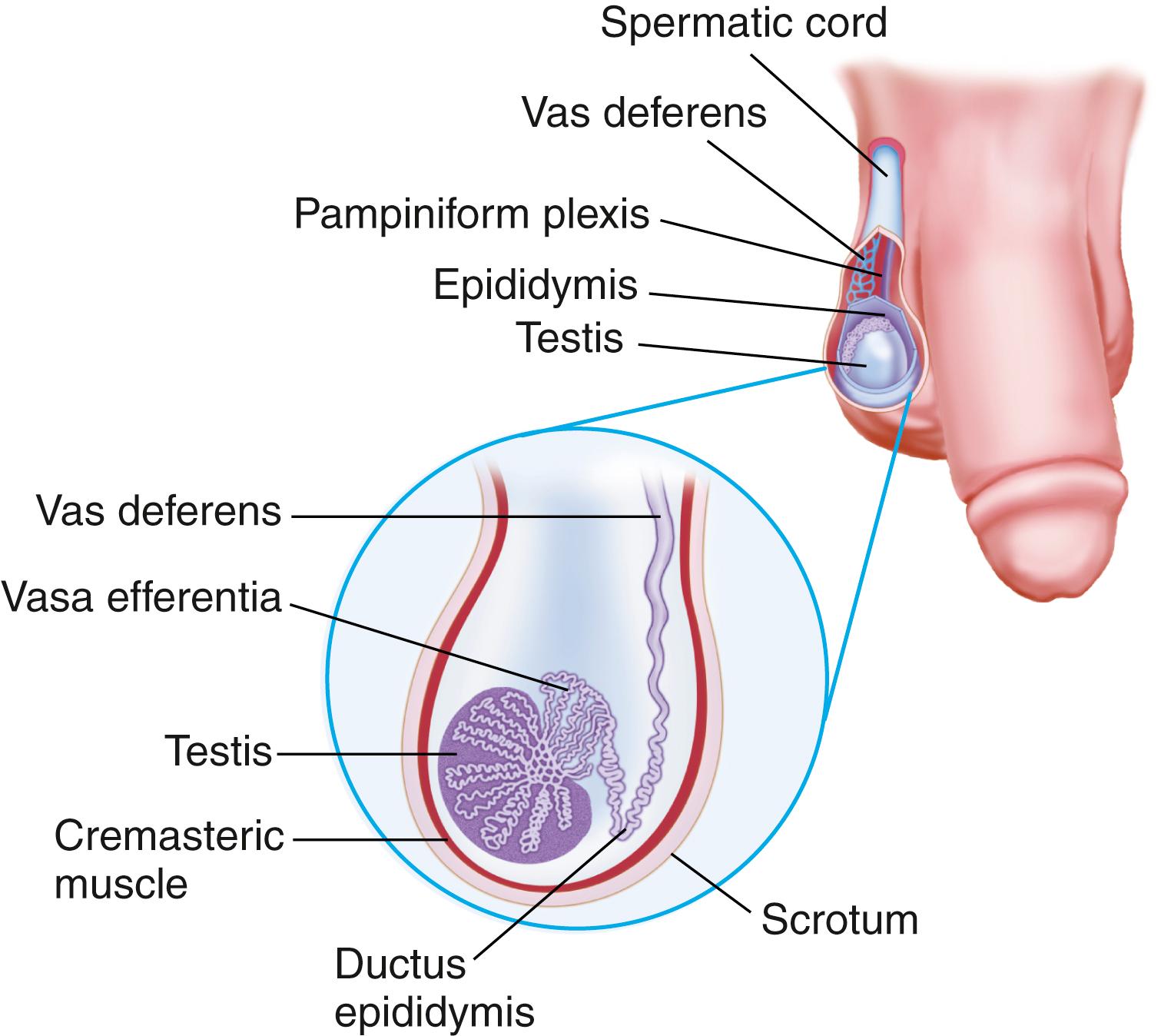Physical Address
304 North Cardinal St.
Dorchester Center, MA 02124
For ease of communication, in this textbook the term “male genitalia” refers to the following anatomic structures: penis, testicles, epididymides, scrotum, prostate gland, and seminal vesicles, regardless of the gender identity of the patient. Examination of the male genitalia is typically performed when a patient presents with a specific concern, as part of the newborn examination, or as part of a routine well child or adult health visit. In adults, examination of the anus, rectum, and prostate (see Chapter 21 ) is often performed at the same time.
Inspect the pubic hair characteristics and distribution
Retract the foreskin if the patient is uncircumcised
Inspect the glans of the penis with foreskin retracted, noting:
Color
Smegma
External meatus of urethra
Urethral discharge
Lesions
Palpate the penis for tenderness and induration
Strip the urethra for discharge
Inspect the scrotum and ventral surface of the penis for:
Color
Texture
Asymmetry
Lesions
Unusual thickening
Presence of hernia
Palpate the inguinal canal for a direct or indirect hernia
Palpate the testes, epididymides, and vasa deferens for:
Consistency
Size
Tenderness
Bleeding, masses, lumpiness, or nodules
Transilluminate masses in the scrotum
Palpate for inguinal lymph nodes
Elicit the cremasteric reflex bilaterally
The penis, testicles, epididymides, scrotum, prostate gland, and seminal vesicles constitute the male genitalia ( Fig. 20.1 ).

The penis serves as the final excretory organ for urine and, when erect, as the means of introducing semen into the vagina. The penis consists of the corpora cavernosa, which form the dorsum and sides, and the corpus spongiosum, which contains the urethra. The corpus spongiosum expands at its distal end to form the glans penis. The urethral orifice is a slitlike opening located approximately 2 mm ventral to the tip of the glans ( Figs. 20.2 and 20.3 ). The skin of the penis is thin, redundant to permit erection, and free of subcutaneous fat. It is generally more darkly pigmented than body skin. Unless the patient has been circumcised, the prepuce (foreskin) covers the glans. In the uncircumcised penis, smegma is formed by the secretion of sebaceous material by the glans and the desquamation of epithelial cells from the prepuce. It appears as a cheesy white material on the glans and in the fornix of the foreskin.


The scrotum, like the penis, is generally more darkly pigmented than body skin. A septum divides the scrotum into two pendulous sacs, each containing a testis, epididymis, spermatic cord, and a muscle layer termed the cremasteric muscle that allows the scrotum to relax or contract ( Fig. 20.4 ). Testicular temperature is controlled by altering the distance of the testes from the body through muscular action. Spermatogenesis requires maintenance of temperatures lower than 37 °C.

The testicles are responsible for the production of both spermatozoa and testosterone. The adult testis is ovoid and measures approximately 4×3×2 cm. The epididymis is a soft, comma-shaped structure located on the posterolateral and upper aspect of the testis. It provides for storage, maturation, and transit of sperm. The vas deferens begins at the tail of the epididymis, ascends the spermatic cord, travels through the inguinal canal, and unites with the seminal vesicle to form the ejaculatory duct.
The prostate gland, which resembles a large chestnut and is approximately the size of a testis, surrounds the urethra at the bladder neck. It produces the major volume of ejaculatory fluid, which contains fibrinolysin. This enzyme liquefies the coagulated semen, a process that may be important for satisfactory sperm motility. The seminal vesicles extend from the prostate onto the posterior surface of the bladder.
Erection of the penis occurs when the two corpora cavernosa become engorged with blood, generally 20 to 50 mL. Arterial dilation and decreased venous outflow pro duce the increased blood supply; both processes are under the control of the autonomic nervous system and occur because of the local synthesis of nitric oxide. Ejaculation during orgasm consists of the emission of secretions from the vas deferens, epididymides, prostate, and seminal vesicles. Orgasm is followed by constriction of the vessels supplying blood to the corpora cavernosa and gradual detumescence (subsidence of the erection).
The external genitalia are sex undifferentiated at 8 weeks of gestation, but by 12 weeks of gestation, sex differentiation has occurred. Any fetal insult during 8 or 9 weeks of gestation may lead to major anomalies of the external genitalia. Minor morphologic abnormalities arise during later stages of gestation.
During the third trimester, the testes descend from the retroperitoneal space through the inguinal canal to the scrotum. At full term, one or both testes may still lie within the inguinal canal, with the final descent into the scrotum occurring in the early postnatal period. Descent of the testicles may be arrested at any point, however, or they may follow an abnormal path.
Small separations between the glans and the inner preputial epithelium begin during the third trimester. Separation of the prepuce from the glans is usually incomplete at birth and often remains so until the age of 3 to 4 years in uncircumcised children.
With the onset of puberty, testicular growth begins and the scrotal skin reddens, thins, and becomes increasingly pendulous. Sparse, downy, straight hair appears at the base of the penis. The penis enlarges in length and breadth. As maturation continues, the pubic hair darkens and extends over the entire pubic area, and the prostate gland enlarges. By the completion of puberty, the pubic hair is curly, dense, and coarse and forms a diamond-shaped pattern from the umbilicus to the anus. The growth and development of the testes and scrotum are complete (see Chapter 8 for stages of genital developmental and sexual maturation).
Pubic hair becomes finer and less abundant with aging, and pubic alopecia may occur. The scrotum becomes more pendulous. An erection may develop more slowly, and orgasm may be less intense.
For each of the symptoms or conditions discussed in this section, targeted topics to include in the history of the present illness are listed. Responses to questions about these topics provide clues for focusing the physical examination and the development of an appropriate diagnostic evaluation. Questions regarding medication use (prescription and over-the-counter preparations) as well as complementary and alternative therapies are relevant for each.
Character of lumps, sores, rash
Discharge: color, consistency, odor, tendency to stain underwear
Symptoms: itching, burning, stinging
Exposure to sexually transmitted infection (STI): multiple partners, infection in partners, failure to use or incorrect condom use, history of prior STI
Intermittent or constant, association with straining or lifting, duration, presence of pain
Change in size or character of swelling
Pain in the groin: character (tearing, sudden, searing, or cutting pain), associated activity (lifting heavy object, coughing, or straining at stool)
Use of supportive undergarment or other treatment
Frequent heavy lifting
Medications: analgesics
Change in testicular size
Events surrounding onset: noted while bathing, after trauma, during a sporting event; sudden onset
Irregular lumps, soreness, or heaviness of testes
Practice of tucking: manually displacing the testes upward into the inguinal canal, and positioning the penis and scrotal skin between the legs and rearward toward the anus. Commonly practiced by transgender women. Tight underwear, tape, or a special garment known as a gaff may be used to maintain this positioning.
Medications: analgesics, antibiotics
Associated pain
Injury to penis
Personal history diabetes, contracture of fourth and fifth fingers of the hand (Dupuytren contracture)
Family history of condition
Medications: propranolol
Current history of sickle cell Disease, leukemia, multiple sclerosis, diabetes, spinal cord injury
Trauma to genitals or groin
Associated with alcohol ingestion or medication
Medications: erectile dysfunction agents, antidepressants, antipsychotics, anticoagulants, anxiolytics, illicit drugs
Painful or premature, efforts to treat the problem
Ejaculate color, consistency, odor, and amount
Medications: alpha blockers, antidepressants, antipsychotics, clonidine, methyldopa
Pain with erection, prolonged painful erection
Constant or intermittent, with one or more sexual partners
Associated with alcohol ingestion or medication
Medications: diuretics, sedatives, antihypertensive agents, anxiolytics, estrogens, inhibitors of androgen synthesis, antidepressants, carbamazepine, erectile dysfunction agents
Lifestyle factors that may increase temperature of scrotum: tight clothing, briefs, hot baths, employment in high-temperature environment or requiring prolonged sitting
Length of time attempting pregnancy, sexual activity pattern, knowledge of fertile period of partner’s reproductive cycle
History of varicocele, hydrocele, or undescended testes
Diagnostic evaluation to date: semen analysis, physical examination, sperm antibody titers
Medications: testosterone, glucocorticoids, hypothalamic releasing hormone, marijuana
Gender identity: e.g., male, female, non-binary, transgender woman, transgender man; sex assignment at birth
Organ inventory: penis (natal or surgically constructed), scrotum and testicles (natal or surgically constructed), prostate gland, clitoris (natal or surgically constructed), vagina (natal or surgically constructed), cervix, uterus, fallopian tubes, ovaries
Congenital anomaly and/or surgery of genitourinary tract: undescended testes, hypospadias, epispadias, hydrocele, varicocele, hernia, prostate; vasectomy
STIs: single or multiple infections, specific organism (gonorrhea, syphilis, herpes, human papillomavirus [HPV]), chlamydia), treatment, effectiveness, residual problems; vaccination for HPV (see Patient Safety Box; HPV Immunization)
Chronic illness: testicular or prostatic cancer, neurologic or vascular impairment, diabetes mellitus, cardiac Disease
Recent and past genitourinary/gynecologic procedures: masculinizing phalloplasty, scrotoplasty, erectile implants, vaginectomy, metoidioplasty (clitoral release/enlargement that may include urethral lengthening), hysterectomy, oophorectomy, orchiectomy, feminizing vaginoplasty
HPV infection can cause cervical, vaginal, vulvar, penile, anal, and oropharyngeal cancers as well as genital warts. Vaccination against HPV before exposure to the virus through sexual activity is recommended for all 11- to 12-year olds. Because parents most often make the decision about this vaccine, the genital examination presents an opportunity to educate about the vaccine and to discuss it in terms of cancer prevention rather than HPV as a sexually transmitted infection. Catch-up HPV vaccination is recommended through age 26 for everyone, if they did not get vaccinated when they were younger and shared clinical decision making is recommended for individuals aged 27 through 45 years who are not vaccinated.
Infertility in siblings
History of prostate, testicular, penile or breast cancer
Hernias
Peyronie Disease (contracture of penis)
Occupational risk of trauma to suprapubic region or genitalia, exposure to radiation or toxins
Exercise: use of a protective device with contact sports or bicycle riding
Concerns about genitalia: size, shape, surface characteristics, texture
Testicular/genital self-examination practices (see Patient Safety, “Self-Examination for STIs”)
Concerns about sexual behaviors including sexual partners (single or multiple)
Concerns about sexual orientation (heterosexual, homosexual, bisexual), or gender identity (transgender, cisgender, agender)
Reproductive function: number of children, form of contraception used, frequency of ejaculation
Alcohol, marijuana use: quantity and frequency
Use of drugs
Maternal use of sex hormones or birth control pills during pregnancy
Circumcised: complications from procedure
Uncircumcised: hygiene measures, retractability of foreskin, interference with urinary stream
Scrotal swelling with crying or bowel movement
Congenital anomalies: hypospadias, epispadias, undescended testes, ambiguous genitalia
Parental concerns with masturbation, sexual exploration
Swelling, discoloration, or sores on the penis or scrotum, pain in the genitalia
Concern for sexual abuse
Knowledge of reproductive function, source of information about sexual activity and function
Presence of nocturnal emissions, pubic hair, enlargement of genitalia, age at time of each occurrence and of first nocturnal emissions
Concern of sexual abuse
Sexual activity, protection used for contraception and STI prevention
Change in frequency of sexual activity or desire: related to loss of spouse or other sexual partner; no sexual partner; sexually restrictive environment; depression; physical illness resulting in fatigue, weakness, or pain.
Change in sexual response: longer time required or inability to achieve full erection, less forceful ejaculation, more rapid detumescence, longer interval between erections, prostate surgery.
Genital self-examination (GSE) is recommended for anyone who is at risk for contracting a sexually transmitted infection (STI). This includes sexually active persons who have had more than one sexual partner or whose partner has had other partners. The purpose of GSE is to detect any signs or symptoms that might indicate the presence of an STI. Many people who have an STI do not know they have one, and some STIs can remain undetected for years. GSE should become a part of routine self-examination healthcare practices. Explain and demonstrate the following procedure to your patients and give them the opportunity to perform a GSE with your guidance.
Instruct the patient to hold the penis in the hand and examine the head. If not circumcised, the patient should gently pull back the foreskin to expose the glans. Inspection and palpation of the entire head of the penis should be performed in a clockwise motion while the patient carefully looks for any bumps, sores, or blisters on the skin. Bumps and blisters may be red or light-colored or may resemble pimples. Have the patient also look for genital warts, which may look similar to warts on other parts of the body. The urethral meatus should also be examined for any discharge.
Next, the patient will examine the entire shaft and look for the same signs. Instruct the patient to separate the pubic hair at the base of the penis and carefully examine the skin underneath. Be sure to include the underside of the shaft in the examination; a mirror may be helpful.
Instruct the patient to examine the scrotal skin and contents; hold each testicle gently and inspect and palpate the skin, including the underneath of the scrotum, looking for any lesions, lump, swelling, or soreness. Educate the patient about other symptoms associated with STIs, specifically pain or burning on urination or discharge from the penis. The discharge may vary in color, consistency, and amount.
Any of the preceding signs or symptoms require evaluation by a healthcare provider.


Infection with high-risk types of HPV
Lack of circumcision with failure to maintain good hygiene
Phimosis
Age: risk increases with age
Smoking (smoking alone increases risk; smokers with HPV infection at even higher risk)
HIV infection
UV light treatment of psoriasis if genitalia exposed
Undescended testicle (cryptorchidism): risk elevated for both testicles
Personal history of testicular cancer (the opposite testicle is at increased risk)
Family history of testicular cancer
HIV infection
Age: 20–34 years
Race: White; five times greater than that of Blacks and more than three times that of Asian Americans and Native Americans
Androgen suppression: likely decreases the risk in transgender women
Become a Clinical Tree membership for Full access and enjoy Unlimited articles
If you are a member. Log in here